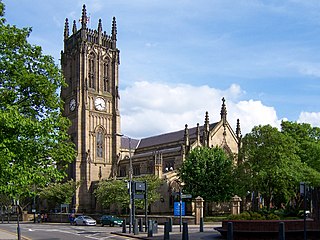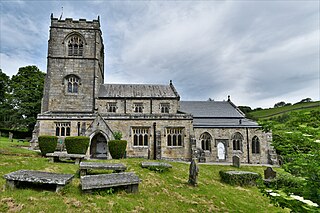
Adel is a suburb of Leeds, West Yorkshire, England. To its immediate south is Weetwood, to the west are Cookridge and Holt Park, to the east are Alwoodley and Moortown, and to the north are Bramhope, Arthington and Eccup.

St Edith's Church, Shocklach, stands at the end of an isolated lane running toward the River Dee about 1 mile (2 km) to the north of the village of Shocklach, Cheshire, England. It is a small Norman church, and is one of the oldest ecclesiastical buildings in Cheshire. The church is recorded in the National Heritage List for England as a designated Grade I listed building and its simple Norman work is considered to be unique in Cheshire. It is an active Anglican parish church in the diocese of Chester, the archdeaconry of Chester and the deanery of Malpas. Its benefice is combined with that of St Mary, Tilston.

Robert Dennis Chantrell was an English church architect, best-known today for designing Leeds Parish Church, now Leeds Minster.

St Michael's Church is in the civil parish of Blennerhasset and Torpenhow, Cumbria, England. It is an active Anglican church in the deanery of Derwent, the archdeaconry of West Cumberland, and the diocese of Carlisle. It is recorded in the National Heritage List for England as a designated Grade I listed building.

St Michael's Church is located by the side of the River Derwent in the dispersed settlement of Isel, in the civil parish of Blindcrake, Cumbria, England. It is an active Anglican parish church in the deanery of Derwent, the archdeaconry of West Cumberland, and the diocese of Carlisle. Its benefice is united with those of nine local churches to form the benefice of Binsey. The church is recorded in the National Heritage List for England as a designated Grade I listed building.

St John the Evangelist's Church is in the village of Crosscanonby, Cumbria, England. It is an active Anglican parish church in the deanery of Solway, the archdeaconry of West Cumberland and the diocese of Carlisle. The church is recorded in the National Heritage List for England as a designated Grade I listed building.

St. Peter's Church is in the village of Kirkbampton, Cumbria, England. It is an active Anglican parish church in the deanery of Carlisle, the archdeaconry of Carlisle, and the diocese of Carlisle. Its benefice is united with those of St Andrew, Aikton, St Mary, Kirkandrews-on-Eden with Beaumont, and St Michael, Burgh by Sands. The church contains Norman architecture and is recorded in the National Heritage List for England as a designated Grade I listed building.

St Mary's Church is a redundant Anglican church in the village of Stainburn, North Yorkshire, England. It is recorded in the National Heritage List for England as a designated Grade I listed building, and is under the care of the Churches Conservation Trust.

St John the Baptist's Church is a redundant Anglican church in the village of Stanwick St John, North Yorkshire, England. It is recorded in the National Heritage List for England as a designated Grade I listed building, and is under the care of the Churches Conservation Trust. The site of the church is recognised as a Scheduled Monument, and it stands within the earthworks of Stanwick Camp, a settlement originating in the early Iron Age.

St John the Evangelist's Church is a redundant Anglican church in the centre of the city of Leeds, West Yorkshire, England. It is recorded in the National Heritage List for England as a designated Grade I listed building, and is under the care of the Churches Conservation Trust. The architectural historian Nikolaus Pevsner refers to it as "the only church at Leeds of more than local interest".

St Mary's Church is a redundant Church of England parish church in the village of Roecliffe, North Yorkshire, England. It is a Grade II* listed building and is in the care of the Churches Conservation Trust.

St Mary's Church is a redundant Anglican church in the village of Little Hormead, Hertfordshire, England. It is recorded in the National Heritage List for England as a designated Grade I listed building, and is under the care of the Churches Conservation Trust. The church is particularly noted for its Norman door, made of wood and ironwork. It is described as a "work of outstanding importance", and a "rare and precious survival".

St Mary's Church is a redundant medieval Anglican church in the village of Barton Bendish, Norfolk, England. This village had two more parish churches –St Andrew's Church, and All Saints' Church (demolished). St Mary's is recorded in the National Heritage List for England as a designated Grade I listed building, and is under the care of the Churches Conservation Trust. The architectural historian Nikolaus Pevsner was of the opinion that its west door is "one of the best Norman doorways in England". The church stands in an isolated position to the west of the village.

The Church of St James the Less is in the village of Tatham, Lancashire, England. It is an active Anglican parish church in the deanery of Tunstall, the archdeaconry of Lancaster and the diocese of Blackburn. Its benefice is united with those of St Wilfrid, Melling, St John the Baptist, Tunstall, St Peter, Leck, the Good Shepherd, Lowgill, and Holy Trinity, Wray, to form the benefice of East Lonsdale. The church is recorded in the National Heritage List for England as a designated Grade II* listed building. It stands above the flood plain of the River Wenning.

St John the Baptist's Church is the parish church of Low Bentham, a settlement in North Yorkshire, in England.

St Wilfrid's Church is the parish church of Burnsall, a village in North Yorkshire, in England.

St Michael's Church is an Anglican church in Copgrove, a village in North Yorkshire, in England.

St Agatha's Church is the parish church of Easby, a village near Richmond, North Yorkshire, in England.

St Mary Magdalene's Church is an Anglican church in Faceby, a village in North Yorkshire, in England.

All Saints' Church is the parish church of Foston, North Yorkshire, a village in England.


























